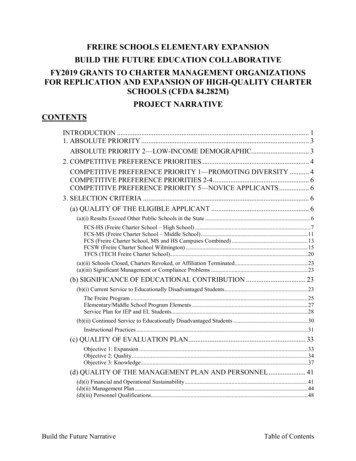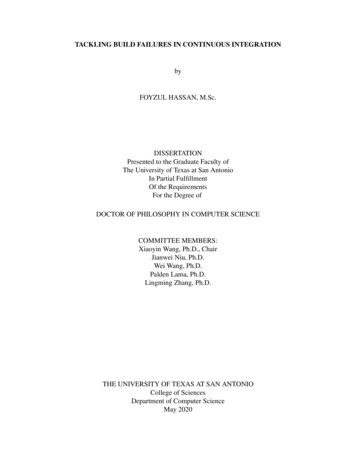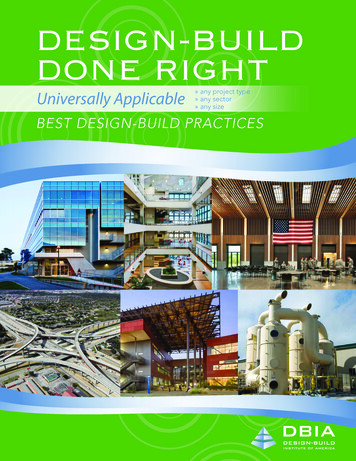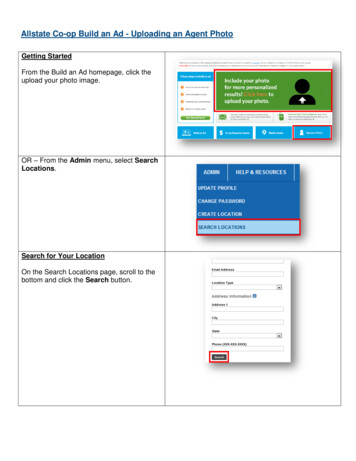
Transcription
FREIRE SCHOOLS ELEMENTARY EXPANSIONBUILD THE FUTURE EDUCATION COLLABORATIVEFY2019 GRANTS TO CHARTER MANAGEMENT ORGANIZATIONSFOR REPLICATION AND EXPANSION OF HIGH-QUALITY CHARTERSCHOOLS (CFDA 84.282M)PROJECT NARRATIVECONTENTSINTRODUCTION . 11. ABSOLUTE PRIORITY . 3ABSOLUTE PRIORITY 2—LOW-INCOME DEMOGRAPHIC. 32. COMPETITIVE PREFERENCE PRIORITIES . 4COMPETITIVE PREFERENCE PRIORITY 1—PROMOTING DIVERSITY . 4COMPETITIVE PREFERENCE PRIORITIES 2-4 . 6COMPETITIVE PREFERENCE PRIORITY 5—NOVICE APPLICANTS . 63. SELECTION CRITERIA . 6(a) QUALITY OF THE ELIGIBLE APPLICANT . 6(a)(i) Results Exceed Other Public Schools in the State .6FCS-HS (Freire Charter School – High School) .7FCS-MS (Freire Charter School – Middle School) . 11FCS (Freire Charter School, MS and HS Campuses Combined) . 13FCSW (Freire Charter School Wilmington) . 15TFCS (TECH Freire Charter School). 20(a)(ii) Schools Closed, Charters Revoked, or Affiliation Terminated. 23(a)(iii) Significant Management or Compliance Problems . 23(b) SIGNIFICANCE OF EDUCATIONAL CONTRIBUTION . 23(b)(i) Current Service to Educationally Disadvantaged Students. 23The Freire Program . 25Elementary/Middle School Program Elements . 27Service Plan for IEP and EL Students . 28(b)(ii) Continued Service to Educationally Disadvantaged Students . 30Instructional Practices . 31(c) QUALITY OF EVALUATION PLAN . 33Objective 1: Expansion . 33Objective 2: Quality . 34Objective 3: Knowledge. 37(d) QUALITY OF THE MANAGEMENT PLAN AND PERSONNEL . 41(d)(i) Financial and Operational Sustainability . 41(d)(ii) Management Plan . 44(d)(iii) Personnel Qualifications. 48Build the Future NarrativeTable of Contents
4. APPLICATION REQUIREMENTS . 53(a) Program Objectives . 53(a)(i) Meeting Student Needs . 53(a)(ii) Transportation. 53(b) History of Outcomes and Results . 54(c) Description of Educational Program . 54(c)(i) Meeting Challenging State Academic Standards . 54(c)(ii) Grade Levels to be Served . 54(c)(iii) Instructional Practices. 54(d) Current Management of more than one Charter School . 55(d)(i) Meets the Definition of “Charter School” . 55(d)(ii) Treated as a Separate School by its Authorizer and State . 55(e) Information on Schools Closed, Charters Revoked, or Affiliation Terminated . 55(f) Logic Model . 55(g) Single-Sex Charter Schools or Activities . 55(h) Management Relationship of Applicant to Schools . 55(i) Parent and Community Input . 55(j) Lottery and Enrollment Procedures . 57(k) Provision of FAPE under IDEA . 58(l) Meeting Challenging State Academic Standards . 59(m) Budget Narrative . 59(n) Audited Financial Statements . 59(o) Enrollment Assistance Plan for Closure . 59(p) Description of Waivers . 60(p)(i) Waivers Requested . 60(p)(ii) Rules Not Applicable to Charter Schools . 60Build the Future NarrativeTable of Contents
INTRODUCTIONFreire is a high achieving network of three urban public charter schools (4 campuses)serving approximately 2,000 students in grades 5-12 in Philadelphia, PA and Wilmington, DE.Driven by the idea that all students can achieve excellence under the right conditions, we providestudents from educationally disadvantaged communities with a rigorous, creative education thatdevelops concrete skills and love-centered values to produce collaborative and courageouscitizen leaders ready to build the future. Our flagship school, Freire Charter School (FCS),opened as a high school in fall 1999 and expanded to serve grades 5-12 (adding a middle schoolcampus) in fall 2012. FCS has a 19-year record of success in closing the achievement gap andpreparing historically underserved Philadelphia students for college. FCS has been a catalyst forunlocking the potential of some of Philadelphia's most underserved youth. Replicating thesuccessful Freire model, Freire Charter School Wilmington (FCSW) opened in fall 2015,followed by TECH Freire Charter School (TFCS) in fall 2016. Freire’s charter managementorganization, Build the Future Education Collaborative (BtF), spun off from FCS on July 1, 2015as a non-profit CMO to manage the three separate charter schools.The world has changed since Freire was founded in 1999, and we are evolving with it.Freire has uniquely served Philadelphia and Wilmington, rising to challenges and utilizingresources in our communities. In addition to providing a rigorous college preparatory program,we have learned that students find the learning process more meaningful when topics are relevantto their lives, needs, and interests. We also know that students need to feel safe before they canmeaningfully participate in their own learning. As such, we combine social-emotional learning,problem-based and creative learning, extensive out of school programming, and partnershipswith outside organizations to create an educational program that is uniquely ‘Freire’ andBuild the Future NarrativePage 1
successful in preparing students for postsecondary success (see our responses to SelectionCriteria (a) and (b) and Appendix I.1 for more detail about our program).Freire is now poised to expand two of its current schools to serve elementary students,working toward providing a full K-12 continuum at those schools, and growing our networkwide student population from 2,000 to 3,250 by the year 2025. To aid in clarity throughout thisapplication, the table below provides a summary of each entity as it relates to this project:TermEntityDetailsFreireAllRefers to all Freire schools and our general approachBtFBuild the FutureEducationCollaborativeOpened in 2015 as a non-profit organization managingall Freire schools; provides executive, educational,operations, financial, and advancement servicesFCSFreire CharterSchoolOpened in 1999 and currently has two campuses: FCSMS with grades 5-8 and FCS-HS with grades 9-12; weplan to build a third campus, FCS-ES, to add grades K-4FCSWFreire CharterSchoolWilmingtonOpened in 2015 and currently has one campus withgrades 8-12 (FCSW-HS); we plan to build a secondcampus, FCSW-E/MS, to add grades K-7TFCSTECH FreireCharter SchoolOpened in 2016 and currently has one campus withgrades 9-12; as TFCS is the newest Freire school,expansion is not being considered at this timeAs these new grades will be added under existing charters, this project is technically anexpansion. We will not need to incorporate new entities, form new governance boards, or set upnew benefits plans. Operationally, these expansions will require nearly every element of openinga new school. Each expansion will require its own new, separate facility and will be led byindependent leadership and school administration separate from the existing campuses. We arelooking for new buildings for these younger grades, forming multiple campuses per charterschool. This will enable Freire to maintain the small school environment that is critical to servingour students’ urgent needs through individual attention and administrative flexibility. At thesame time, the network model affords our school leaders the ability to depend on their colleaguesBuild the Future NarrativePage 2
across the network for advice, as well as on the CMO for administrative support needs andguidance so that they can focus their full attention on students.1. ABSOLUTE PRIORITYABSOLUTE PRIORITY 2—LOW-INCOME DEMOGRAPHICFreire Schools Low-Income Summary 2018-19 (Oct 1)FreireFCSFCSWGrades Currently Served5-125-128-12Number of Students19741002479Low-Income Students1,265661244Low-Income Percentage64%66%51%TFCS9-1249336073%The table above shows the percentages of students from low-income families across allschools BtF manages, using Direct Certification figures for Eligibility for Free and ReducedPrice Meals under the National School Lunch Program. As indicated, our network-widepercentage (64%) and each individual school meets Absolute Priority 2 as they exceed therequirement of 40%. Further, schools that collect NSLP Meal Benefits Applications traditionallyreport significantly higher low-income percentages than schools that use the Direct Certificationmethod. For this reason, USDA rules currently use a multiplier of 1.6 to create NSLP eligibility,putting our network-wide projected equivalent low-income number at 100%.Using solely the naturally lower Direct Certification figures, Freire has a demonstratedhistory of serving a low-income population exceeding the 40% CSP requirement. Our networkwide low-income percentage was 52% in 2014-15, 50% in 2015-16, and 55% in 2016-17. Wewill maintain a similar network-wide percentage of low-income students during the grant periodby recruiting students from economically disadvantaged areas and likely locating new buildingsin such areas as well. The Freire program is specifically designed to be inclusive ofdisadvantaged students, including low-income students, making such students a good fit for ourBuild the Future NarrativePage 3
schools. Freire will maintain this focus as we continue to build our reputation, support network,and student body. See Appendix E for more information.2. COMPETITIVE PREFERENCE PRIORITIESCOMPETITIVE PREFERENCE PRIORITY 1—PROMOTING DIVERSITYAll Freire schools emphatically observe nondiscrimination requirements contained in theU.S. Constitution and Federal and State civil rights laws. Consistent with PA and DE charterschool laws, no Freire schools use weighted lotteries or enrollment preferences to attempt toreach demographic quotas. Students come to our schools through family choice and randomizedlottery. In Philadelphia, Freire has a long-running reputation for quality within the AfricanAmerican community, and, while we welcome any and all students, due to overwhelmingdemand from that community the lottery outcome is that our students are predominantly AfricanAmerican. With Freire’s positive track record for high achievement, the opportunity to open anelementary school in Philadelphia renews our opportunity to recruit students from racially andsocioeconomically diverse backgrounds at a younger age.With Freire being new to Delaware, FCSW, meanwhile, has the opportunity to place anintentional focus on recruiting and retaining students from racially and socioeconomicallydiverse backgrounds and maintaining a racially and socioeconomically diverse student body as itcontinues to build its reputation, support network, and student body. The highest performingcharter schools in Delaware (all containing high percentages of Caucasian and Asian studentsand low percentages of African American, Hispanic, and low-income students and students withdisabilities) each currently rely on geographic or academic enrollment preferences that, in effect,heavily skew their enrollments to the highest performing students. Our intent is for FCSW tobecome one of the highest performing charter schools in Delaware, but to do so while attractingBuild the Future NarrativePage 4
students that do not come from privilege, but rather any students who have the drive, desire anddream to graduate from college, start a career, and better their communities.Wilmington and its surrounding communities have had a long history of educationalsegregation, with federal intervention taking place on more than one occasion. Within thecontext of the desegregation actions that Delaware has taken since the late 1970s, school districtlines were re-drawn. The City of Wilmington was divided into sections, creating several districtseach including suburbs and a portion of the city. Wilmington students were bussed outside thecity center to peripheral suburban locations far from home. The result of this was devastating toWilmington in myriad ways. FCSW has sought to foster diversity through intentional location.By placing our building in the city center, we have allowed Wilmington residents, again, theirown local high school; in fact, FCSW is presently the only public college preparatory schoolinside city limits serving grades 9-12. A location in central Wilmington appeals to the widestgroup of community members possible without being considered dominated by any one racialgroup. Furthermore, a location in the city, where the majority of residents are low-income,provides the low-income population of Wilmington with access to a top-notch collegepreparatory public school close to home.Since opening, FCSW has maintained a diverse racial composition that has included afour-year average of 70% African American, 12% white, 12% Hispanic, and 6% other nonwhitestudents. We plan to maintain or increase the level of racial diversity with the expansion toyounger grade levels, as we have found through informal market analysis that starting earlier willfacilitate diversity in recruitment. Early students tend to be demographically clustered (attendingchild care or living on blocks or in buildings with homogeneous demographics), making targetedrecruitment efforts more efficient. In Delaware, high school alumni affiliations are very strong,Build the Future NarrativePage 5
which presented a hurdle when recruiting for a brand new high school. With a youngerpopulation, families will be more open to exploring innovative educational options. Finally, wewill publish our promotional materials and application form in more languages and seekbilingual student recruitment staff.Regarding socioeconomic diversity, we project FCSW maintaining a low-incomepercentage of around 50%, which represents a range of family financial situations.COMPETITIVE PREFERENCE PRIORITIES 2-4We are not competing for these priorities.COMPETITIVE PREFERENCE PRIORITY 5—NOVICE APPLICANTSBuild the Future (BtF) qualifies as a Novice Applicant because while FCSW and TFCShave previously received CSP grants through the CSP Developer program (formerly known asthe non-SEA program), BtF has never received a federal grant, including under this program orany other discretionary program, since opening in 2015, nor has it been funded as a member of agroup application submitted in accordance with 34 CFR 75.127-75.129.3. SELECTION CRITERIA(a) QUALITY OF THE ELIGIBLE APPLICANT(a)(i) Results Exceed Other Public Schools in the StateFreire has nearly two decades of success in raising student achievement for a largelyeducationally disadvantaged student population and preparing them for success in college at ratesthat exceed local, state, and national averages for low-income students. At our flagship school,FCS-HS, we have exceeded the School District of Philadelphia’s performance on the Keystoneassessment in Literature and Algebra every year since 2013-14. Our first expansion project,FCS-MS, demonstrates our ability to successfully transfer our educational model to a youngerpopulation. In 2017-18, there is significant evidence that FCS-MS exceeded the state benchmarkBuild the Future NarrativePage 6
for growth in Math, ELA, and Science. FCS-MS also had the highest growth score in Math ofany middle school across PA. Our two newest schools are able to boast early success. At FCSW,in our first year receiving a rating for SAT results (2017-18) our proficiency rate in ELAexceeded the state average. TFCS exceeded the standard for PA academic growth in Literatureand Biology and met the standard for academic growth in Algebra in 2017-18. In Algebra, thereis evidence that TFCS students in all achievement groups met the standard for Pennsylvaniaacademic growth. Supporting data for this Selection Criterion can be found in Appendix G.As TFCS and FCSW prepare to graduate their first senior classes, we are excited tomonitor our alumni to see how our high school graduates grow into college graduates. At thesame time, the entire Freire network seeks to build upon its successes and continue to raise ourrates of student proficiency. Below we have outlined the Freire network’s performance data,including data for educationally disadvantaged students. As assessments differ across state andgrade configurations differ across the network, we present this data on a school by school basis.FCS-HS (Freire Charter School – High School)Build the Future NarrativePage 7
FCS-HS has a proven track record of academic success over the past two decades. Duringthe time when the state used the PSSA (Pennsylvania System of School Assessment) for highschool grades and FCS was a high school only (2003-2012), we demonstrated a dramatic upwardtrend in proficiency rates over time, becoming comparable to the state average. Since 2012-13,Pennsylvania has assessed students in Algebra, Literature, and Biology using the Keystone Exam(primarily for 11th grade, although students could test earlier based on course sequencing).Keystone Results: FCS-HS Compared to School District of Philadelphia(All Students)100%90%80%70%60%71%75%68%68%77% 75%74%69%59% 55%55%54% 54%50%51%41%40%FCS-HSSDP30%20%10%0%2014 2015 2016 2017 2018 2014 2015 2016 2017 2018 2014 2015 2016 2017 2018AlgebraLiteratureBiologyFCS-HS has exceeded the School District of Philadelphia’s performance on the Keystoneassessment in Literature and Algebra every year since 2013-14. Freire has received notableindications of success from the PA Department of Education. In 2015, based on the State’saccountability system, Freire ranked in the top five high schools in Philadelphia (and wasthe only school in the top five with open enrollment serving primarily low-income studentsof color). We were also proud to be recognized as a Title I Distinguished School in that year.In 2017-18, 54% of 11th graders were proficient in Algebra compared to 38% at the District;51% of 11th graders were proficient in Biology compared to 36% at the District; and 69% ofBuild the Future NarrativePage 8
11th graders were proficient in Literature compared to 49% at the District. Our teacher coachingprogram, our work aligning teacher-created assessments to standards, and our 11th gradeinterventions have all contributed to this strong performance.FCS-HS has also had great success in serving educationally disadvantaged students. ThePennsylvania Department of Education (PDE) accountability system uses the subgroup“Historically Underperforming Students,” which is defined as a non-duplicated count of studentswith disabilities, economically disadvantaged students, and English Learners (we use this termfor consistency with state reporting, though we would prefer to say “historically underserved”).For the past three years, FCS-HS’s Historically Underperforming Students have exceeded thestate average in Algebra, Biology, and Literature. In 2017-18, 50% of historicallyunderperforming FCS-HS students were proficient in Algebra compared to the 45% Stateaverage; 49% of historically underperforming students were proficient in Biology compared tothe 44% State average; and 70% of historically underperforming students were proficient inLiterature compared to the 55% State average.AlgebraLiteratureBiologyBuild the Future SDP2018FCS-HS100%90%73% 72% 70%80%70% 65%49%54%60%52% 6201820172016100%90%73% 72% 70%80%65%70%49%54%60%52% 55%50%50%40%30%20%10%0%Keystone Results: FCS-HS Compared toPennsylvania(Historically Underperforming)2016Keystone Results: FCS-HS Compared toSchool District of Philadelphia(Historically Underperforming)BiologyPage 9FCS-HSPA
While we are proud to be continually outperforming other schools in these ways, we havenot ignored a schoolwide dip in proficiency across all three disciplines over the past three years.In response, we have changed FCS-HS’s academic leadership, hired a new network-wideDirector of Learning to provide teacher and leader coaching, and implemented Renaissance Star360 benchmark assessments with fidelity. We undertook these initiatives because we remaincommitted to continuous improvement for every Freire student.We are also proud of the growth our students have achieved at FCS-HS. Using the threeyear average as calculated by PDE, there is significant evidence that our students have exceededthe benchmark for growth in Algebra and Biology and moderate evidence that they haveexceeded the benchmark in Literature. Our 2018 Algebra results showcase the fulfillment of ourgrowth goals: we not only maintained overall significant evidence that our students exceeded thestate benchmark for growth, but further, students from all achievement quintiles exceeded thestandard for growth and FCS-HS was in the 87th percentile for growth in Algebra statewide.This impressive growth demonstrated the success of restructuring our math program that year.As a college prep school, we feel that post-secondary outcomes speak strongly to ouracademic success. For the years in which we have comparative data (up to 2015-16), our schoolwide graduation rates approach the state average and consistently outperform the SchoolDistrict of Philadelphia. When looking at low-income students, we have begun to exceed thestate average. Our graduation rate has steadily increased over the past three years, from 82% in2015-16 to 87% in 2017-18.College matriculation and persistence over time have been strong. Over the past fiveyears, an average of 93% of our students have been accepted to college and plan to attend atsome point, while 77% have seamlessly enrolled the fall after graduating from Freire. Nationally,Build the Future NarrativePage 10
only 68% of high school graduates enroll in college seamlessly (National Student Clearinghouse[NSC]). We have a team of staff who provide college advising, plan numerous college trips, andoffer a seminar for parents to support the college search process. We also recently began usingNaviance, a web-based college planning tool, to provide additional guidance and support.More importantly, based on a four-year average, 84% of Freire alumni who startcollege persist to the second year of college (reaching a high of 92% in 2014), as comparedto a national average of 72% (NSC). Our college graduation rate also far exceeds the nationalaverage. FCS-HS’s college completion rate within six years after high school graduationaverages 37% over the past three years, as compared to a national average of just 25% for highminority, low-income students from public non-charter schools (NSC). These norm-defyingresults are a testament to the work Freire does to prepare students for the rigor of collegeacademics.FCS-MS (Freire Charter School – Middle School)In 2012, FCS expanded to add a separate middle school campus serving grades 5-8. Thenew FCS-MS replicated key elements of the FCS-HS program while adapting them for youngergrades. Through changes in state assessments (including realignment to PA Core Standards),FCS-MS has found its stride and has been showing improvement year after year. Weconsistently exceed the School District of Philadelphia’s assessment results and are now oneof the top middle schools in the city.In Pennsylvania, students in grades 3-8 are assessed using the PSSA, with Math andEnglish Language Arts tested in grades 3-8 and Science tested in grades 4 and 8. In 2014-15, thePSSA was realigned to the PA Core Standards (Pennsylvania’s response to the Common Core).This realignment resulted in statewide drops on the PSSA; for example, the number of studentsBuild the Future NarrativePage 11
scoring proficient or better on the Math PSSA across PA dropped by 35.4 percentage points.FCS-MS, which had just opened under the previous assessment, saw its test scores decrease for atwo-year period. The 2015-16 results in particular brought to our attention the need to realign theFCS-MS curriculum to the new PA Core standards as measured by the PSSAs, so that in futureyears our students would be properly prepared for the tests. The first year after that realignment,we outperformed our peer schools in all three subjects, but neither the District nor the chartersector as a whole. In response, our lead teachers ventured further, this time further tweaking thecurriculum, changing our benchmark assessments to ensure that all relevant standards werecovered and assessed prior to testing, and finding a better balance between the PSSA Scienceanchors and the Next Generation Science Standards. We also changed our approach to academicinterventions, building intervention time into the daily schedule and using data to respondappropriately to students’ individual needs. Finally, we made significant changes to ourclassroom-based assessments and our daily schedule.In 2016-17, we saw a significant increase of 9 percentage points in proficiency in ELA, 7percentage points in Science, and 4 percentage points in Math, demonstrating positive results forthese changes. In 2017-18 we again posted gains in all three subjects, outperforming the Districtin each. Specifically, 51% of students were proficient in ELA compared to 37% at the District,35%36%27%MathELABuild the Future NarrativeScience20%SDP10%0%39%27%32% 30%13% 16% 152018201720160%201510%Freire201721%18%20% 11% 1642%201850%201760%51%PSSA Results: FCS-MS Compared toS.D. of Phila (Hist. Underperforming)201660%PSSA Results: FCS-MS Compared toSchool District of Phila. (All Students)SciencePage 12
21% were proficient in Math compared to 19% at the District, and 36% were proficient inScience compared to 26% at the District. FCS-MS was the second highest performing generaladmission Philadelphia public school in ELA and Math and the 4th highest in Science (thisexcludes schools that have achievement-related admissions criteria). For educationallydisadvantaged students, the middle school’s 2017-18 PSSA scores for historicallyunderperforming stud
Freire Charter School Wilmington : Opened in 2015 and currently has one campus with grades 8-12 (FCSW-HS); we plan to build a second campus, FCSW-E/MS, to add grades K-7 TFCS . TECH Freire Charter School : Opened in 2016 and currently has one campus with grades 9-12; as TFCS is the newest Freire school, expansion is not being considered at this .










